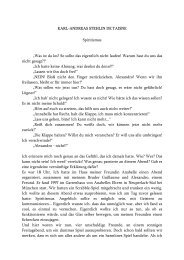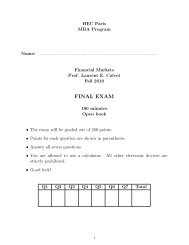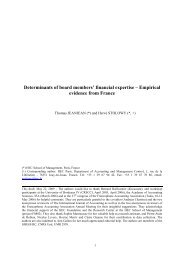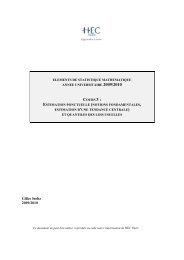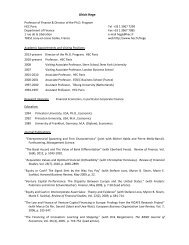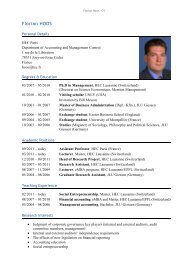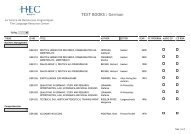Multifractality of US Dollar/Deutsche Mark Exchange Rates - Studies2
Multifractality of US Dollar/Deutsche Mark Exchange Rates - Studies2
Multifractality of US Dollar/Deutsche Mark Exchange Rates - Studies2
You also want an ePaper? Increase the reach of your titles
YUMPU automatically turns print PDFs into web optimized ePapers that Google loves.
6 at about two hours. For the remainder <strong>of</strong> this paper, we consider primarily the long range <strong>of</strong><br />
sampling intervals greater than two hours. These sampling intervals still span nearly three orders<br />
<strong>of</strong> magnitude <strong>of</strong> △t. The absence <strong>of</strong> a sharp upper crossover in this region, at least up to 180 days,<br />
is promising.<br />
We conjecture that high-frequency crossover can be related to market frictions such as bid-ask<br />
spreads, discreteness <strong>of</strong> trading units, and discontinuous trading. This topic will be investigated in<br />
a forthcoming paper.<br />
3.4.2 The Self-Affinity Index for BH(t)<br />
A close up view <strong>of</strong> the slopes <strong>of</strong> the partition functions around the moments q = 2 is chosen in<br />
Figure 6 for a particular purpose. The self-affinity index, H, <strong>of</strong> the Fractional Brownian Motion<br />
BH(t) in the MMAR is identified by the condition that<br />
where τP is the scaling function for the price process. 16<br />
τP (1/H) =0, (6)<br />
From Figure 6, the value <strong>of</strong> q with slope zero appears to be about 1.9, indicating H ≈ .53. This<br />
implies small persistence in DM/<strong>US</strong>D exchange rates. At the same time, the estimated H is very<br />
close to 1/2. Previous studies, based on well understood estimation methods, find white spectra<br />
(implying H =1/2) for log increments <strong>of</strong> typical financial data. Thus, the martingale hypothesis<br />
for log prices seems to be a reasonable approximation. At the same time, Section 5 shows strong<br />
evidence <strong>of</strong> multifractality in trading time, implying long memory in squared returns.<br />
3.4.3 Linearity <strong>of</strong> the Partition Functions<br />
Linearity <strong>of</strong> the partition functions in Figure 6 indicates a multifractal scaling law that holds, at a<br />
minimum, for close to three orders <strong>of</strong> magnitude <strong>of</strong> △t. Scaling is even more striking in Figure 7<br />
because the moments are higher, reaching to q = 5. Once again, the lines are relatively straight,<br />
consistent with the MMAR. Variability <strong>of</strong> the lines around their apparent slopes increases as q<br />
increases, as is to be expected.<br />
16 In a partition with fixed endpoints where all increments are restricted to have the same sign, the sum <strong>of</strong> increments<br />
cannot depend on grid size. Intuitively, the total variation <strong>of</strong> an increasing process, estimated by finite increments,<br />
does not depend on how we cut it up. Therefore, since θ(t) is increasing (being the c.d.f. <strong>of</strong> a random measure),<br />
τθ(1) = 0. For a Fractional Brownian Motion, τ(q) =Hq − 1, and τP (q) =τθ(Hq) by Theorem 4.2 in MFC(1997).<br />
This establishes that τP (1/H) = 0. See CFM and Mandelbrot (1997) for further discussion.<br />
11



